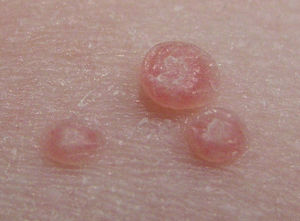We need you! Join our contributor community and become a WikEM editor through our open and transparent promotion process.
Molluscum contagiosum
From WikEM
Contents
Background
- Self-limited skin condition caused by Molluscum Contagiosum Virus, member of poxvirus family
- Most common in children 0-14yo.[1]
- Also affects sexually active adults and immunocompromised patients[2]
- Transmitted via direct contact (including sexual contact) or fomites.
Clinical Features
- Begins as painless, small papule
- Becomes raised, pearly, flesh-colored dome with central umbilication (called "mollusca")[2]
- Cental umbilication contains plug of virus-filled white caseous material.
- Can be solitary or multiple, and can affect any part of the body.
- Genital mollusca on pediatric patients should prompt concern for child abuse (although autoinnoculation is a possibility)[3]
Differential Diagnosis
Pediatric Rash
- Drug rash
- Erythema Infectiosum (Fifth disease)
- Hand-foot-and-mouth disease
- Henoch-Schonlein Purpura (HSP)
- Herpangina
- Herpes simplex virus
- Infectious Mononucleosis
- Meningitis
- Measles
- Molluscum contagiosum
- Roseola infantum
- Rubella German measles)
- Scarlet fever
- Smallpox
- Varicella (Chickenpox)
Evaluation
- Clinical diagnosis, based on history and physical examination
- Biopsy with histology can confirm diagnosis if unclear
Management
- Self-limited - no specific treatment necessary
- Lesions resolve within 6-18 months in immunocompetent patients[2]
- Treatment may be warranted in immunocompromised patients, for cosmesis, or to prevent autoinnoculation
- Treatment options[2]
- Cryotherapy - liquid nitrogen, dry ice, etc.
- Scrub with betadine or retin-A 0.025% gel for 5 minutes daily
- Surgical excision (may cause scarring)
- PO antivirals (e.g. Cidofovir)
Disposition
- Discharge
See Also
External Links
References
- ↑ Olsen JR, Gallacher J, Piguet V, Francis NA. Epidemiology of molluscum contagiosum in children: a systematic review. Fam Pract. 2014 Apr;31(2):130-6. doi: 10.1093/fampra/cmt075.
- ↑ 2.0 2.1 2.2 2.3 Nandhini G, Rajkumar K, Kanth KS, Nataraj P, Ananthakrishnan P, Arunachalam M. Molluscum Contagiosum in a 12-Year-Old Child – Report of a Case and Review of Literature. Journal of International Oral Health : JIOH. 2015;7(1):63-66.
- ↑ Zhuang K, Ran Y, Xu F, Lama J. Atypical infantile genital Molluscum contagiosum. Anais Brasileiros de Dermatologia. 2015;90(3):403-405. doi:10.1590/abd1806-4841.20153298.
Authors
Michael Holtz, Ross Donaldson, Neil Young, Daniel Ostermayer


